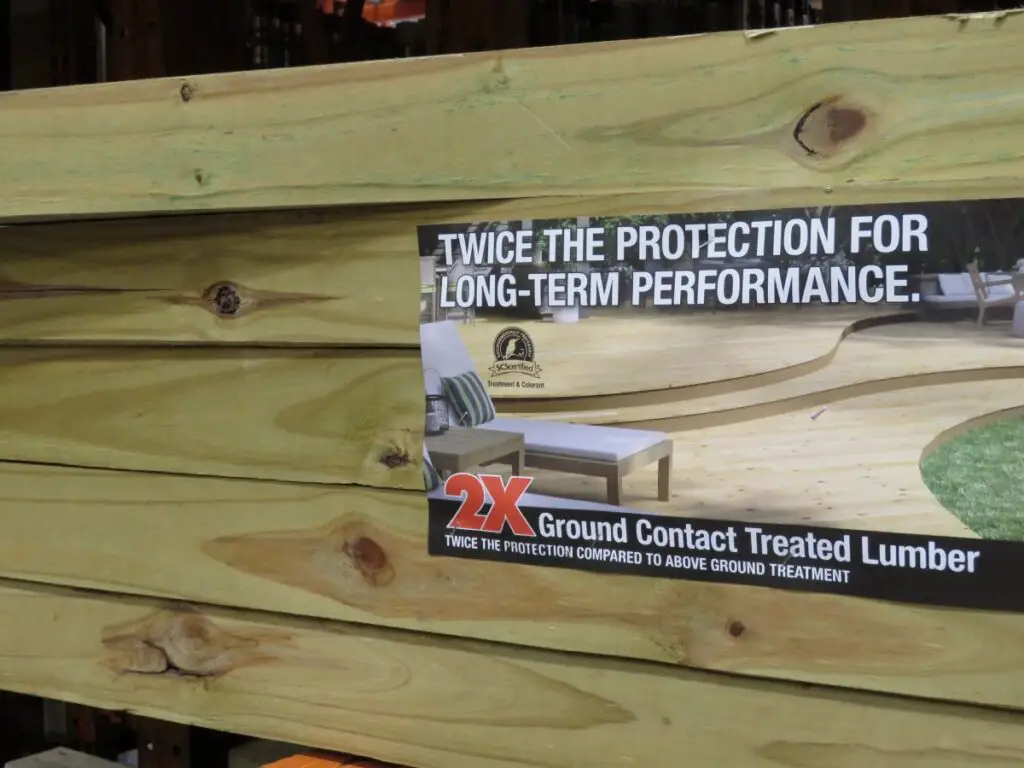Table of Contents
- Introduction
- Pressure-Treated Lumber Weight Calculator
- About These Weight Values
- Table: Pressure-Treated Lumber Weight by Board Size
- Wood Pressure Treatment Process
- Type of Wood Used for Pressure Treating
- Weight of Water in Pressure-Treated Wood
- Weight of Preservative in Pressure-Treated Lumber
- Ask the Lumber Company!
- Resources for Information on Pressure-Treated Wood

Introduction
The weight of pressure-treated lumber depends on how much time has gone by since the wood was treated, as well as the size of the board or post. Most pressure-treated lumber is made from southern yellow pine, which is a relatively heavy wood to begin with, so pressure-treated wood does tend to be heavier than most other lumber because of this alone.
But the weight that people really notice when it comes to treated lumber is the water weight that the wood picks up while being treated. A 6×6×10-foot long treated post weighs about 153 pounds immediately after being pressure treated, but it will only weigh around 87 pounds after it has had time to fully air dry. A 10-foot-long 2×6 pressure-treated board will weigh around 42 pounds right after being treated. The same board will only weigh around 24 pounds after it has had time to dry out.
Pressure-Treated Lumber Weight Calculator
This calculator generally uses the weight values given in the table farther down the page.
How to Use the Calculator
Start by selecting the wood species in the Select Wood Species dropdown list. This sets the base density in pounds per cubic foot (lb/ft³). Southern Yellow Pine – Generic (40 lb/ft³) is selected by default because it is the most common wood type used for pressure treated lumber. There are a few other built-in options if you know the exact species. You can also enter a custom wood density (see more wood densities).
Next, choose the nominal board dimensions (for example, 2 × 10) from the dropdown list. The calculator will automatically display the actual thickness and width for the selected size.
Enter the board length using the Feet and Inches inputs together. These should be considered together as one length input. For instance, if your board is 12 ft 6 in long, enter 12 in the Feet field and 6 in the Inches field.
Enter the total number of boards of this size and length.
Use the slider to select the drying stage of the wood to reflect the current amount of water retained in the wood. The slider adjusts the density of the selected wood species by applying the appropriate drying-stage modifier. Freshly Treated lumber (all the way to the left) will be the heaviest as it is lumber straight from the treatment tank and still fully-saturated with preservative solution. Half Dry (in the middle) reflects partially dried wood often found at the store or lumber yard, and Fully Air Dried (all the way to the right) represents lumber that has fully air dried to 12% moisture content (this can sometimes take months).
Click Calculate to see the weight per linear foot, total length and weight of all boards, and total board volume, along with a detailed breakdown of the calculations.
About These Weight Values
The values used in the calculator and the following table indicate the heaviest probable approximate weight (dead load, self-weight) of pressure-treated lumber at various stages. The weight values in the table are for pressure-treated wood immediately after being treated, for pressure-treated wood after it has dried thoroughly, and for untreated wood with the same dimensions.
The values given are for one of the densest wood species, longleaf pine (southern yellow pine, longleaf), commonly used to produce pressure treated lumber. Less dense wood species are sometimes pressure treated as well, but this table is intended to give you an idea as to what pressure-treated wood might weigh at its heaviest.
The “freshly treated” column in the chart shows the weight for the wood when it contains the highest amount of water commonly added to the wood during treatment (close to four gallons, or about 32 lbs., per cubic foot).
Table: Pressure-Treated Lumber Weight by Board Size
For an explanation of the difference between nominal lumber dimensions and actual dimensions, see Nominal vs Actual Lumber Dimensions: Chart & Explanation. The values in the table are approximate due to rounding (and wood weight values always vary a little anyway).
| Weight of Pressure Treated Lumber | ||||
|---|---|---|---|---|
| (Made from the Longleaf Pine Species of Southern Yellow Pine) | ||||
| Nominal Dimensions of Lumber in Inches |
Actual Dimensions of Lumber in Inches |
Untreated Lumber Weight (Air Dried Lumber) |
Freshly Treated Lumber Weight (Maximum Weight) |
Treated Lumber Weight After Drying |
| Cubic Foot | 12 x 12 x 12 | 41 pounds per Cubic Foot |
73 pounds per Cubic Foot |
41.6 pounds per Cubic Foot |
| Board Foot | 12 x 12 x 1 | 3.42 pounds per Board Foot |
6.08 pounds per Board Foot |
3.47 pounds per Board Foot |
| Per Linear Foot: | Per Linear Foot: | Per Linear Foot: | ||
| 1 inch x 2 inch | 0.75 inch x 1.5 inch | 0.32 lb | 0.57 lb | 0.32 lb |
| 1 x 3 | 0.75 x 2.5 | 0.53 lb | 0.94 lb | 0.54 lb |
| 1 x 4 | 0.75 x 3.5 | 0.75 lb | 1.34 lb | 0.76 lb |
| 1 x 6 | 0.75 x 5.5 | 1.17 lb | 2.08 lb | 1.18 lb |
| 1 x 8 | 0.75 x 7.25 | 1.55 lb | 2.76 lb | 1.57 lb |
| 1 x 10 | 0.75 x 9.25 | 1.98 lb | 3.52 lb | 2.00 lb |
| 1 x 12 | 0.75 x 11.25 | 2.40 lb | 4.27 lb | 2.42 lb |
| 5/4 x 6 | 1 x 5.5 | 1.57 lb | 2.79 lb | 1.59 lb |
| 5/4 x 8 | 1 x 7.25 | 2.06 lb | 3.67 lb | 2.09 lb |
| 2 x 2 | 1.5 x 1.5 | 0.64 lb | 1.14 lb | 0.65 |
| 2 inch x 3 inch | 1.5 inch x 2.5 inch | 1.07 lb | 1.90 lb | 1.08 lb |
| 2 x 4 | 1.5 x 3.5 | 1.49 lb | 2.65 lb | 1.5 lb |
| 2 x 6 | 1.5 x 5.5 | 2.34 lb | 4.17 lb | 2.36 lb |
| 2 x 8 | 1.5 x 7.25 | 3.09 lb | 5.50 lb | 3.12 lb |
| 2 x 10 | 1.5 x 9.25 | 3.95 lb | 7.03 lb | 3.99 lb |
| 2 x 12 | 1.5 x 11.25 | 4.80 lb | 8.54 lb | 4.85 lb |
| 2 x 14 | 1.5 x 13.25 | 5.65 lb | 10.06 lb | 5.71 lb |
| 2 x 16 | 1.5 x 15.25 | 6.52 lb | 11.61 lb | 6.58 lb |
| 3 x 4 | 2.5 x 3.5 | 2.51 lb | 4.44 lb | 2.53 lb |
| 3 x 6 | 2.5 x 5.5 | 3.91 lb | 6.96 lb | 3.95 lb |
| 3 inch x 8 inch | 2.5 inch x 7.25 inch | 5.19 lb | 9.19 lb | 5.24 lb |
| 3 x 10 | 2.5 x 9.25 | 6.59 lb | 11.73 lb | 6.65 lb |
| 3 x 12 | 2.5 x 11.25 | 8.01 lb | 14.26 lb | 8.09 lb |
| 3 x 14 | 2.5 x 13.25 | 9.43 lb | 16.79 lb | 9.52 lb |
| 3 x 16 | 2.5 x 15.25 | 10.85 lb | 19.31 lb | 10.96 lb |
| 4 x 4 | 3.5 x 3.5 | 3.49 lb | 6.21 lb | 3.52 lb |
| 4 x 6 | 3.5 x 5.5 | 5.48 lb | 9.75 lb | 5.53 lb |
| 4 x 8 | 3.5 x 7.25 | 7.22 lb | 12.85 lb | 7.29 lb |
| 4 x 10 | 3.5 x 9.25 | 9.23 lb | 16.43 lb | 9.32 lb |
| 4 x 12 | 3.5 x 11.25 | 11.22 lb | 19.97 lb | 11.33 lb |
| 4 inch x 14 inch | 3.5 inch x 13.25 inch | 13.21 lb | 23.51 lb | 13.34 lb |
| 4 x 16 | 3.5 x 15.25 | 15.2 lb | 27.06 lb | 15.35 lb |
| 6 x 6 | 5.5 x 5.5 | 8.61 lb | 15.33 lb | 8.69 lb |
| 6 x 8 | 5.5 x 7.25 | 11.35 lb | 20.20 lb | 11.46 lb |
| 6 x 10 | 5.5 x 9.25 | 14.48 lb | 25.77 lb | 14.62 lb |
| 6 x 12 | 5.5 x 11.25 | 17.62 lb | 31.36 lb | 17.79 lb |
| 6 x 14 | 5.5 x 13.25 | 20.75 lb | 36.94 lb | 20.95 lb |
| 6 x 16 | 5.5 x 15 | 23.49 lb | 41.81 lb | 23.72 lb |
| 8 x 8 | 7.25 x 7.25 | 14.97 lb | 26.65 lb | 15.12 lb |
| 8 x 10 | 7.25 x 9.25 | 19.09 lb | 33.98 lb | 19.28 lb |
| 8 inch x 12 inch | 7.25 inch x 11.25 inch | 23.22 lb | 41.33 lb | 23.45 lb |
| 8 x 14 | 7.25 x 13.25 | 27.35 lb | 48.68 lb | 27.62 lb |
| 8 x 16 | 7.25 x 15 | 30.97 lb | 55.13 lb | 31.27 lb |
| 8 x 18 | 7.25 x 17 | 35.10 lb | 62.48 lb | 35.44 lb |
| 10 x 10 | 9.25 x 9.25 | 24.37 lb | 43.38 lb | 24.61 lb |
| 10 x 12 | 9.25 x 11.25 | 29.62 lb | 52.72 lb | 29.91 lb |
| 10 x 14 | 9.25 x 13.25 | 34.89 lb | 62.10 lb | 35.23 lb |
| 10 x 16 | 9.25 x 15 | 39.51 lb | 70.33 lb | 39.90 lb |
| 10 x 18 | 9.25 x 17 | 44.78 lb | 79.71 lb | 45.22 lb |
| 12 x 12 | 11.25 x 11.25 | 36.04 lb | 64.15 lb | 36.39 lb |
| 12 inch x 14 inch | 11.25 inch x 13.25 inch | 42.44 lb | 75.54 lb | 42.86 lb |
| 12 x 16 | 11.25 x 15 | 48.04 lb | 85.51 lb | 48.51 lb |
Wood Pressure Treatment Process
Pressure-treated lumber is produced by using high pressure to force a solution of water and chemical preservatives deep into the wood. Stacks of lumber are placed in a large steel cylinder in a bath of water and preservative. This tank is pressurized until the wood becomes fully-saturated. After the wood dries out, the preservative remains in the wood, protecting it from decay for years.
Type of Wood Used for Pressure Treating
Around 85% of the pressure-treated wood in the US is made from southern yellow pine. There are a few different sub-species of southern yellow pine, with different wood densities. I used the longleaf variety to calculate the values shown in the chart.
See Weight of Dimensional Lumber for the weights of other wood species commonly used for lumber. A much more extensive list of wood densities, which includes the other varieties of southern yellow pine, can be found in “Weights of Various Woods Grown in the United States“.
Weight of Water in Pressure-Treated Wood
The noticeable extra weight of pressure-treated lumber is due to the water added during the treatment process. Typically, close to four gallons of water (almost 32 pounds) is added to each cubic foot of pressure-treated wood. This means that the wood weighs over 75% more when it comes out of the tank than when it goes in. As the wood returns to its normal air dried weight over the following weeks or months, it also returns (almost) to its pre-treated weight.
Weight of Preservative in Pressure-Treated Lumber
Once it dries, the weight difference between pressure-treated lumber and untreated lumber of the same wood species is entirely due to the weight of the preservative retained in the wood. This weight is minimal. The maximum additional weight due to preservative is around 1.5% for “ground contact” designated lumber using CCA (chromated copper arsenate) or ACQ (alkaline copper quaternary) as a preservative.
For much of the pressure-treated lumber available today for residential use, the additional weight will be less. “Ground contact” lumber treated with the widely-used CA-C (copper azole, type C), for instance, will only weigh about 0.37% more than untreated wood.
Ask the Lumber Company!
The values given in the table above are meant to provide a general idea of typical pressure-treated lumber weights, and should not be used if precise values are needed for critical engineering calculations.
When precision is necessary, always refer to the specification sheet for the actual, specific product you intend to use, or contact the technical department of the lumber producer.
Resources for Information on Pressure-Treated Wood
- Guidelines for Selection and Use of Pressure-Treated Wood – Forest Products Laboratory, US Forest Service, USDA
- PreservedWood.org, the website of the the Western Wood Preservers Institute (WWPI)

